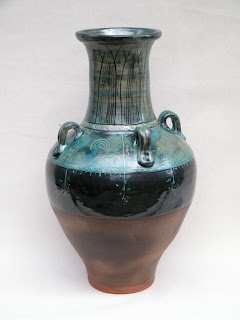 |
| 23.5 x 13 inches (595 x 330mm) |
 |
| 28 x 11.75 inches (710 x 300mm) |
 |
| Milk jug, 7.5 x 6 inches (190 x 152mm) |
 |
| Each approximately 6 1/2 x 5 1/8 inches (165 x 130mm) including lids. |
 |
| Planter, 7 1/4 x 8 1/8 inches (185 x 205mm) |
 |
| 9 3/4 x 12 1/4 inches (250 x 310mm) including spout and handle. |
 |
| Taking photos of work is always a challenge with would be starlets in attendance! |
 |
| Glazed wall planter, 5 3/4 x 7 1/2 inches (145 x 190mm) |
 |
Unglazed wall planter, 6 x 9 inches (152 x 228mm)
|
The photos are of pots that were in the last wood firing that we did on September 25th. Of the pots in this firing, I was particularly pleased with the milk jug. For various reasons (such as messing up the glazing of the outside and having to scrape it off and re-do it), this jug nearly did not make it to the firing... and I am so glad that it did! The glaze is much the same as the one on the pot the first photo on this post, but I added 7 percent tin oxide to it to opacify it. The jug was in one of the hottest places in the kiln, and there is a little movement in the glaze which is most attractive. The glaze ranges from shades of blue-green to blue, and is complex and interesting. Almost impossible to photograph unfortunately.
I also added tin oxide to another alkaline copper glaze, and this gave me the blue glaze that you see on the lidded jars. Tin oxide in mild reduction atmospheres can give a lustre (which is one reason I opted to use tin instead of the less expensive opacifier zirconium silicate), and you see this effect on the glazed wall planter, which is another alkaline copper glaze opacified with tin oxide. I am excited by these glazes, they are a further development of the ones that I mentioned in my previous post, the ones that I made from my own recipes. Each firing I am learning about what the new glazes will do, and firing in the wood fired kiln was a particularly interesting test for a copper glaze, because copper is sensitive to kiln atmosphere, and a green glaze can turn red if fired in an atmosphere that is "starved" of oxygen (a reduction atmosphere).
Tin oxide is a fascinating metal, with a long history. I read that it was mined for about 4000 years in Cornwall in the UK, and this fact alone indicates that there was a sophisticated and technically advanced society in Britain a long, long, time before the Romans got there! Tin mining ceased in Cornwall in 1998, which seems appalling to me somehow... like another species going extinct. (There is a lot of information about mining in Cornwall on the wikipedia.
Mining in Cornwall and Devon is a good place to start.)
In pottery glazes you could add tin oxide to a clear glaze to turn it opaque or white. Unfortunately tin is very expensive. Often it is better to use zirconium silicate to make glazes white and opaque as this material costs less than tin, and can even do a better job in some situations. As an opacifier Zirconium silicate is not as powerful as Tin, and I use about 12 percent in a glaze to produce a similar effect to 7 percent Tin oxide.
Tin oxide is a material with "personality" and can do a lot more than make white. Tin assists copper reds to develop, it is essential for chrome-tin pinks, it can make iron oxide produce strong reds, and it can give a pearly lustre to a glaze with the right kiln atmosphere.
















Comments
That is praise indeed! Thank you very much, it is nice to be cheered on as we emerge from the depths of winter here (actually Spring going into summer now..., but chilly and windy out there this morning).
Hi Linda,
I love blues too, both colours and the music! "Wall pocket", is a great name for the little planter I must remember to use it as it describes it so well.
Hi Judy,
Handles.... they give me a lot of trouble most of the time, but I like the curve of that one and the space between it and the jug. Recently I did some that pulled in too close to the pot as the handles dried.